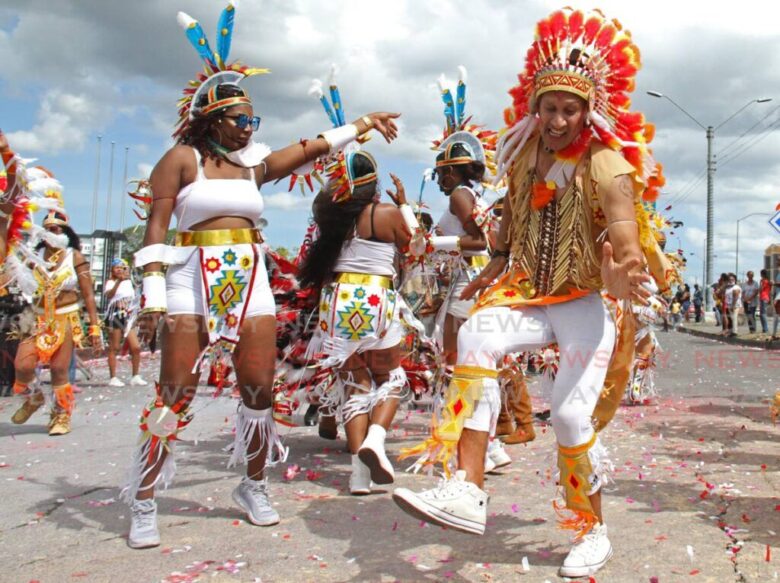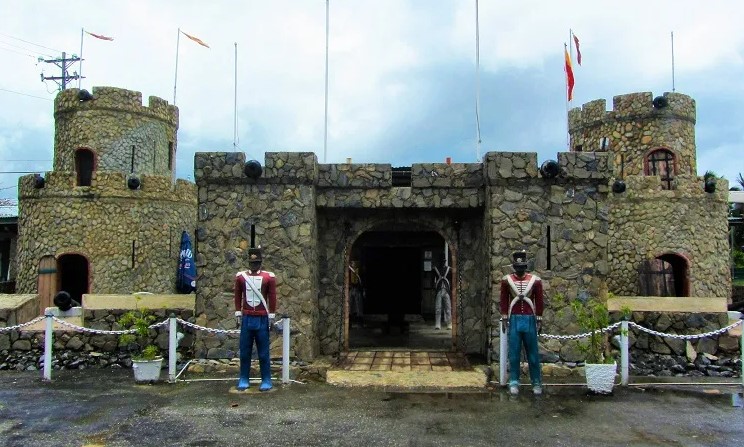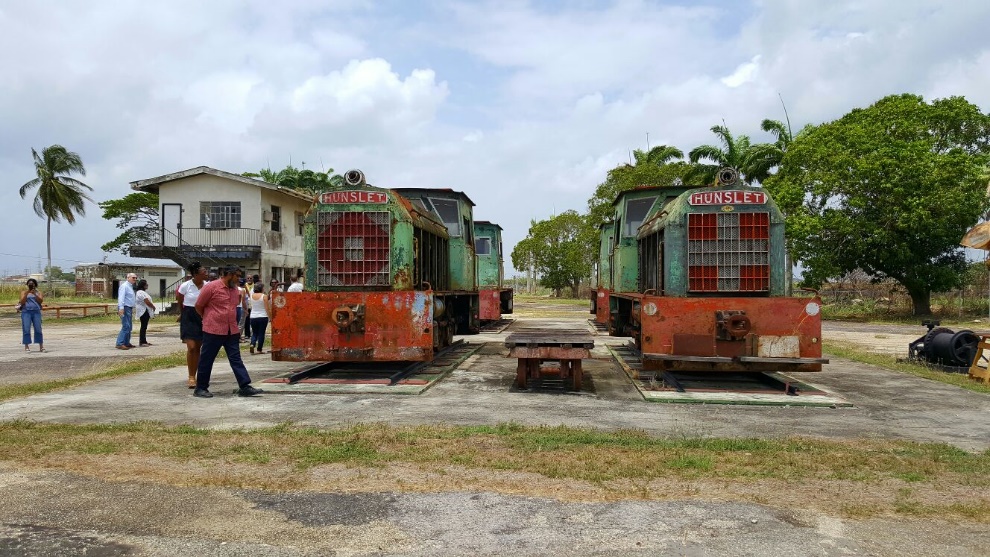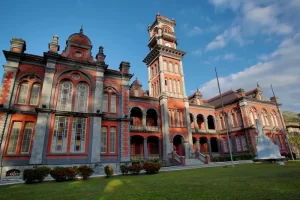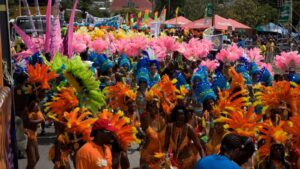Contents
- 1 Carnival Behind the Scenes: The Artisans of Trinidad’s Festivity
- 2 1: The Significance of Trinidad’s Carnival
- 3 2: The Diverse Artisans of the Carnival
- 4 3: Dressing the Celebration – The Figurinists and Seamstresses
- 5 4: Crafting the Spectacle – Sculptors and Decorators
- 6 5: The Beat of Carnival – Musicians and Composers
- 7 6: Preparations and Challenges
- 8 7: Carnival Day
- 9 8: The Importance of Preserving Traditions
- 10 Conclusion: Celebrating the Artisans Behind Trinidad’s Carnival
- 11 Final Remarks:
- 12 Discovering Trinidad and Tobago: An Investment Guide by InvesTT
- 13 Exploring Trinidad’s Military Heritage: Fortresses and Battles
- 14 Trinidad’s Railways: Tracks to the Island’s History
Carnival Behind the Scenes: The Artisans of Trinidad’s Festivity
The Carnival of Trinidad and Tobago is a celebration that reverberates with the rhythm of culture, color, and creativity. It’s a spectacle that draws crowds from around the world, captivating their hearts and souls. While the vibrant parades and infectious music take center stage, there exists a world of artistry, craftsmanship, and dedication behind the scenes that often goes unnoticed but is essential to the Carnival’s success.
Crafting the Carnival Magic: The Unsung Heroes
As we immerse ourselves in the lively festivities of the Trinidad Carnival, it’s easy to be enchanted by the dazzling costumes, elaborate floats, and pulsating rhythms. Yet, hidden beneath this extravagant façade are the unsung heroes, the artisans, whose expertise and passion are the driving force behind the carnival’s allure.
Exploring the Crucial Role of Artisans
In this exploration, we delve into the intricate web of talent and craftsmanship that breathes life into the Trinidad Carnival. Our journey will unveil the masters of design, the skilled sculptors, the melodious composers, and the meticulous costumers who work tirelessly to transform mere ideas into vibrant reality. We’ll see how these artisans, through their dedication and artistry, elevate the Carnival to a world-renowned extravaganza.
As we uncover the stories behind these talented individuals, we’ll gain a deeper appreciation for the cultural significance and artistic magnificence that the Carnival embodies. Join us on this journey behind the scenes as we shed light on the indispensable role of these artisans, often working quietly in the background, in making the Trinidad Carnival the breathtaking spectacle that it is today.
1: The Significance of Trinidad’s Carnival
Trinidad and Tobago’s Carnival: A Brief Historical Journey
Trinidad and Tobago’s Carnival is not merely an annual event; it’s a living testament to the rich tapestry of the nation’s history and culture. Its roots trace back to the 18th century when French settlers introduced the tradition of masquerade balls and festivities, blending with the African traditions brought by enslaved individuals. Over time, this fusion evolved into the vibrant celebration we know today.
The Cultural and Social Tapestry of Carnival
This carnival transcends being a mere festivity; it’s a cultural mosaic that reflects the heart and soul of Trinidad and Tobago. It is a time when the nation’s diverse ethnic groups, including African, Indian, European, and Indigenous influences, converge to create a harmonious celebration of unity. Beyond the flamboyant costumes and pulsating music, Carnival serves as a cultural touchstone, reaffirming identity, and fostering a sense of belonging.
Unveiling the Carnival’s Hidden Gem: The Backstage
While the public sees the Carnival as a dazzling showcase of creativity, it’s essential to recognize the intricate web of craftsmanship and dedication that takes place behind the scenes. The artists, artisans, and craftsmen working tirelessly year-round to bring the celebration to life remain hidden from the spotlight, yet they are the heartbeats of this grand extravaganza. In this section, we’ll take you on a journey to discover the lesser-known but profoundly impactful world of the Carnival’s backstage artisans.
2: The Diverse Artisans of the Carnival
An Array of Artisans
The Trinidad Carnival is a symphony of talent and expertise that encompasses a diverse range of artisans. From the visionaries who craft majestic costumes to the sculptors who breathe life into colossal floats, and the musicians who compose the infectious beats, every artisan plays a pivotal role in the preparation and execution of this grand celebration. Let’s take a closer look at some of the key artisanal groups and their invaluable contributions:
Figurinists and Costume Designers
At the forefront of the Carnival’s visual spectacle are the figurinists and costume designers. These artists are the creative minds behind the breathtaking and elaborate costumes worn by revelers during the festivities. With an intricate understanding of color theory, fashion design, and cultural symbolism, they transform fabrics and materials into stunning works of wearable art. Their expertise ensures that every feather, bead, and sequin is meticulously placed, creating the dazzling costumes that bedazzle the crowds.
Sculptors and Float Builders
The sculptors and float builders are the architects of the Carnival’s physical manifestations. They are responsible for crafting the larger-than-life sculptures, props, and floats that parade through the streets of Trinidad. These skilled artisans use a variety of materials, from foam and papier-mâché to steel and wood, to construct the awe-inspiring structures that contribute to the immersive Carnival experience. Their craftsmanship transforms ideas and concepts into tangible, awe-inspiring creations.
Musicians and Composers
The heart and soul of the Trinidad Carnival’s auditory landscape lie in the hands of its musicians and composers. These individuals possess a deep understanding of the intricate rhythms, melodies, and cultural influences that define the event’s music. Whether it’s the pulsating soca beats or the melodious calypso tunes, musicians and composers work tirelessly to create the soundscape that keeps revelers dancing throughout the celebrations. Their compositions serve as the soundtrack to the Carnival’s vibrant atmosphere.
Each Artisan, a Vital Thread in the Tapestry
In summary, the Carnival of Trinidad and Tobago is not merely a product of chance or happenstance. It is the result of a harmonious collaboration among a myriad of artisans, each contributing their unique skills and expertise. Together, they weave a tapestry of artistry and culture that captivates the senses and creates an unforgettable experience for all who partake in this extraordinary celebration. In the following sections, we will delve deeper into the roles and contributions of these artisans, shedding light on the magic they bring to the Trinidad Carnival.
3: Dressing the Celebration – The Figurinists and Seamstresses
Unveiling the Artistry of Figurinists and Seamstresses
Among the many skilled artisans behind the scenes of the Trinidad Carnival, the figurinists and seamstresses stand out as the maestros of costume design. These talented individuals are responsible for creating the extravagant and visually stunning costumes that adorn revelers during the festivities. Let’s delve into the intricacies of their work, from the meticulous craftsmanship to the profound significance of colors and themes in Carnival attire.
Crafting Extravagant Costumes
The process of designing and crafting Carnival costumes is a labor of love that begins months in advance. Figurinists and seamstresses work hand in hand, starting with the conceptualization of the costume’s design. This phase involves careful consideration of themes, cultural motifs, and the use of vibrant colors that capture the spirit of the Carnival. Once the design is finalized, the real magic begins.
Materials such as feathers, beads, sequins, and fabrics of various textures are selected with great care. Each element is chosen to not only create a visually stunning costume but also to ensure comfort and durability for the wearers who will dance and revel in these outfits for hours on end. The craftsmanship involved in assembling these materials into intricate patterns and designs is awe-inspiring.
The Significance of Colors and Themes
Colors play a pivotal role in Carnival costumes, as they are not chosen at random. They are chosen to convey specific meanings and emotions. For example, the use of vibrant reds and oranges may symbolize the energy and passion of the Carnival, while blues and greens can represent the natural beauty of the islands. These carefully selected color palettes help tell a story and communicate the essence of Trinidad’s culture and heritage.
Themes, often drawn from folklore, history, or contemporary issues, provide an additional layer of depth to the costumes. They allow for the expression of cultural identity and serve as a form of storytelling through visual art. Whether it’s a costume inspired by the folklore of the Jab Molassie or a portrayal of a historic event, themes add layers of meaning that resonate with both participants and spectators.
In Conclusion
The work of figurinists and seamstresses is a testament to their artistic talent and dedication to preserving and advancing the traditions of the Trinidad Carnival. Through their craft, they not only create beautiful costumes but also convey the essence of Trinidad’s culture and the spirit of the celebration. As we continue our journey behind the scenes, we will uncover more about the roles and contributions of other artisans who make the Carnival of Trinidad and Tobago an unparalleled experience.
4: Crafting the Spectacle – Sculptors and Decorators
The Artistry of Sculptors and Decorators
As we continue our exploration behind the scenes of the Trinidad Carnival, we shift our focus to the unsung heroes responsible for the grandeur of the event’s physical environment – the sculptors and decorators. These skilled artisans are the masterminds behind the creation of awe-inspiring sets, backdrops, and props that transform the streets into a captivating wonderland. In this section, we will delve into the intricacies of their work, highlighting their contribution to the festive atmosphere.
Creating Impressive Settings and Props
Sculptors and decorators possess a unique ability to turn ordinary spaces into extraordinary realms of imagination. Their work begins with conceptualizing the visual elements that will complement the Carnival’s themes and narratives. Whether it’s recreating historical landmarks, mythical creatures, or vibrant tropical landscapes, these artisans meticulously plan and design each element to enhance the overall spectacle.
Materials range from traditional mediums like wood and steel to more modern ones like foam and fiberglass, each selected for its suitability in realizing the envisioned creations. Sculptors carve and shape these materials with precision, bringing to life massive floats, intricate sculptures, and elaborate props that defy the imagination.
Contributing to the Festive Atmosphere
The creations of sculptors and decorators are integral to setting the stage for the Carnival’s festive atmosphere. These impressive backdrops and props serve as visual anchors, transporting revelers and spectators into a world of wonder and celebration. They provide a sense of place and context, allowing participants to immerse themselves fully in the themes and stories being portrayed.
The towering floats, adorned with dazzling colors and intricate details, become the focal points of the parades. They inspire awe and excitement, infusing the Carnival with a sense of grandeur. The carefully curated décor creates a cohesive and immersive experience, inviting spectators to become part of the festivities.
In Conclusion
The work of sculptors and decorators is a testament to their artistic vision and technical skill. They are the architects of the Carnival’s visual landscape, shaping the environment in which the celebration unfolds. Through their creations, they contribute significantly to the vibrant and festive atmosphere that defines the Trinidad Carnival, ensuring that every corner of the event is a spectacle waiting to be discovered. As we continue our journey, we will uncover more about the roles and contributions of other artisans who make this celebration a truly unique experience.
5: The Beat of Carnival – Musicians and Composers
Spotlight on Musicians and Composers
As we venture further into the heart of the Trinidad Carnival, we come to a group of artisans whose contributions are felt in every dancer’s step and every reveler’s heart – the musicians and composers. These gifted individuals are the architects of the Carnival’s auditory landscape, shaping the rhythms and melodies that infuse life into the festivities. In this section, we will shine a light on their roles and delve into the interplay between traditional and modern rhythms, and the pivotal role of music in energizing the Carnival.
The Maestros Behind the Music
Musicians and composers are the pulse of the Trinidad Carnival, harnessing the power of sound to create an irresistible atmosphere of celebration. They are masters of traditional Caribbean music genres like calypso and soca, as well as contemporary influences that have seeped into the Carnival’s musical repertoire. These artisans carry a deep understanding of the cultural roots and historical significance of the melodies they produce.
Traditional vs. Modern Rhythms
The Trinidad Carnival’s musical landscape is a captivating fusion of tradition and modernity. Musicians and composers draw inspiration from the rich legacy of calypso and soca, infusing these traditional rhythms with innovative elements. While the beats of steelpan drums and the storytelling prowess of calypsonians pay homage to the Carnival’s historical roots, modern instrumentation and global influences have ushered in a new era of musical diversity.
This blending of traditional and modern rhythms adds depth and complexity to the auditory experience of the Carnival. It ensures that the event appeals to a wide range of tastes, from those who appreciate the nostalgia of classic calypso to those who crave the infectious energy of contemporary soca.
Music’s Role in Carnival Energy
The music of the Trinidad Carnival is more than just a backdrop; it is the life force that propels the festivities forward. The infectious beats and spirited lyrics set the tempo for the parades, encouraging revelers to dance, jump, and celebrate with unbridled enthusiasm. The Carnival’s energy is intrinsically linked to the music, with each note and chord acting as a catalyst for joy and revelry.
Musicians and composers understand the responsibility they bear in creating an atmosphere that resonates with the hearts and feet of the Carnival’s participants. Their compositions serve as anthems of unity, freedom, and cultural expression, elevating the Carnival to a transcendent experience.
In Conclusion
The musicians and composers of the Trinidad Carnival are more than just entertainers; they are cultural custodians and architects of joy. Their ability to blend tradition with innovation, and to infuse the celebration with infectious rhythms, ensures that the Carnival remains a dynamic and ever-evolving spectacle. Their melodies echo through the streets, creating an irresistible invitation for all to join in the revelry and dance to the beat of Trinidad’s heart. As we continue our journey behind the scenes, we will uncover more about the roles and contributions of other artisans who make the Trinidad Carnival an extraordinary celebration of culture and life.
6: Preparations and Challenges
Acknowledging the Challenges Faced by Artisans
While the Trinidad Carnival is a dazzling spectacle, it’s important to recognize the challenges that the artisans working behind the scenes often contend with. These challenges, ranging from tight deadlines to budget constraints, are very much a part of the Carnival’s intricate preparation process. In this section, we will shed light on the hurdles these artisans face and explore the creative ways they overcome them to craft an incredible experience.
Tight Deadlines and the Race Against Time
One of the most pressing challenges for Carnival artisans is the race against the clock. The preparation for the event begins months in advance, but the sheer scale of the work requires meticulous planning and execution. Figurinists, seamstresses, sculptors, decorators, and musicians all have to adhere to tight schedules to ensure that their contributions are ready for the grand stage. The pressure to meet deadlines without compromising quality is a constant battle.
Budget Constraints and Resourcefulness
Budget limitations are another common challenge faced by Carnival artisans. The creation of costumes, floats, sets, and compositions requires a substantial amount of resources, and funding can often be scarce. Artisans must find creative ways to make the most of their budgets, whether it’s through resourceful material sourcing, volunteer efforts, or collaborative partnerships within the Carnival community.
Adaptability and Resilience
In the face of these challenges, Carnival artisans demonstrate remarkable adaptability and resilience. They are masters at finding innovative solutions to unexpected problems. Whether it’s improvising with materials, adjusting designs, or reworking schedules, their ability to adapt ensures that the show goes on without compromising on quality or creativity.
The Triumph of Creativity Over Obstacles
Despite the hurdles, it is the unwavering commitment and passion of these artisans that drive them to overcome challenges and create a truly exceptional Carnival experience. Their dedication to preserving and elevating Trinidad’s cultural heritage is evident in every detail, from the intricacies of costume designs to the harmonious melodies that fill the air.
It is this spirit of creativity, resourcefulness, and resilience that ultimately transforms the Carnival’s obstacles into opportunities for innovation. These artisans not only bring their crafts to life but also infuse them with the magic that makes the Trinidad Carnival a celebration like no other. As we journey through the Carnival’s backstage, we gain a deeper appreciation for the dedication and determination that fuel this extraordinary event.
7: Carnival Day
The Grand Day of Carnival
Carnival Day in Trinidad is the culmination of months of preparation, anticipation, and creative craftsmanship. It is the day when the vibrant tapestry of Trinidad’s culture and artistry is on full display for the world to see. In this section, we will paint a picture of the Carnival’s grand day, exploring how artisans unite to create a memorable spectacle and the enthusiastic response it elicits from the community and visitors alike.
The Unison of Artisans
On Carnival Day, the various artisanal groups come together like a finely orchestrated symphony. Figurinists, seamstresses, sculptors, decorators, musicians, and composers, each bearing the fruits of their labor, assemble to bring their creations to life. The atmosphere is charged with excitement and camaraderie as artisans work tirelessly to ensure that every detail is in place.
Costumes are donned, floats are adorned with their impressive sculptures, and musicians prepare to serenade the streets. There is a palpable sense of unity as everyone plays their part, contributing to the immersive experience that awaits the revelers and spectators.
Creating a Spectacular Memory
The synergy of these artisans on Carnival Day results in a sensory overload that leaves an indelible mark on those who witness it. The streets are transformed into a kaleidoscope of colors and sounds, with towering floats, dazzling costumes, and infectious music creating an immersive wonderland.
The costumes, meticulously crafted by figurinists and seamstresses, take center stage as they are showcased by enthusiastic participants. Sculptors and decorators’ creations serve as the backdrop for these performances, adding a sense of grandeur and spectacle to the event. The musicians and composers provide the soundtrack, infusing the air with the rhythmic heartbeat of Trinidad’s culture.
The Enthusiastic Response
The response from both the local community and visitors is a testament to the Carnival’s impact. For the people of Trinidad and Tobago, Carnival is a source of immense pride and a celebration of their cultural identity. It fosters a sense of togetherness and belonging, as neighbors, friends, and strangers come together to revel in the shared experience.
Visitors, too, are captivated by the Carnival’s magic. They are welcomed with open arms into the festivities, often becoming honorary Trinidadian “Carnivalists” for the day. The vibrancy and exuberance of the event leave a lasting impression, making it an unforgettable cultural experience.
In Conclusion
Carnival Day in Trinidad is more than just a day of celebration; it is a culmination of artistry, culture, and unity. It is a testament to the dedication and passion of artisans who work tirelessly behind the scenes to create an unforgettable spectacle. The response from the community and visitors underscores the profound impact of this celebration, solidifying its place as one of the world’s most remarkable cultural festivals. As we conclude our journey behind the scenes of the Trinidad Carnival, we reflect on the power of art, music, and culture to bring people together and create moments of pure joy and celebration.
8: The Importance of Preserving Traditions
Reflecting on the Significance of Carnival Tradition
As we conclude our journey through the vibrant world of the Trinidad Carnival, it’s essential to pause and reflect on the profound importance of preserving the traditions that make this celebration a cultural jewel. The Carnival is not just a spectacular event; it is a living testament to the spirit, history, and identity of Trinidad and Tobago. In this final section, we will explore the significance of safeguarding these traditions and the role of artisans in passing down knowledge and skills, as well as how the Carnival has evolved over time.
The Role of Artisans in Preserving Tradition
The artisans who labor tirelessly behind the scenes of the Carnival are not only creators but also custodians of tradition. Their work is deeply rooted in the cultural and historical fabric of Trinidad and Tobago. Figurinists, seamstresses, sculptors, decorators, musicians, and composers carry forward the legacies of their predecessors, infusing their creations with the knowledge and craftsmanship of generations.
Through mentorship, apprenticeships, and the transmission of artistic techniques, these artisans ensure that the essence of the Carnival is passed down from one generation to the next. This continuity is vital for preserving the authenticity and cultural significance of the event.
The Evolution of Carnival
The Carnival of Trinidad and Tobago has undergone a remarkable evolution over time. What began as a fusion of European masquerade traditions and African rhythms during the colonial era has evolved into a global phenomenon that embraces diverse influences. The Carnival has adapted to changes in society, politics, and culture, reflecting the dynamic nature of the nation itself.
While preserving its core traditions, the Carnival has embraced modern elements, such as electronic music, contemporary fashion, and innovative materials, ensuring its relevance and appeal to new generations. This ability to evolve while staying true to its roots is a testament to the resilience and adaptability of the Carnival.
The Enduring Legacy
In conclusion, the Trinidad Carnival is not just a celebration; it is a living heritage that connects the past, present, and future. It is a celebration of the nation’s resilience, unity, and creativity. The artisans who pour their hearts and souls into the Carnival are not only creators of beauty but also guardians of culture.
By preserving and passing down their knowledge and skills, artisans ensure that the Trinidad Carnival remains a vibrant and culturally significant event for generations to come. The Carnival’s evolution reflects the ever-changing nature of Trinidad and Tobago while staying true to its roots. It stands as a shining example of how tradition and innovation can coexist harmoniously, reminding us of the enduring power of art and culture to bring people together and celebrate the richness of the human spirit.
Conclusion: Celebrating the Artisans Behind Trinidad’s Carnival
In the tapestry of the Trinidad Carnival, the artisans are the hidden threads that weave together a masterpiece of culture, creativity, and celebration. Throughout our exploration, we’ve unveiled the vital roles they play in crafting the spectacle that captivates hearts and souls. It is imperative to recapitulate their importance and reiterate our thesis, inviting all to appreciate and value the remarkable work of these behind-the-scenes artisans.
The Heartbeat of Trinidad’s Carnival
From the figurinists and seamstresses who craft extravagant costumes to the sculptors and decorators who shape the grandeur of the event, and from the musicians and composers who provide the rhythmic soul to the artisans’ unwavering dedication, each artisan plays a pivotal role in bringing the Carnival to life. Their craftsmanship, creativity, and commitment transform mere ideas into the grand, vibrant, and culturally rich celebration that is the Trinidad Carnival.
Thesis Reaffirmed
Our thesis stands strong: the artisans are the foundation of the Carnival’s success. Their expertise, passion, and dedication are what elevate this event beyond mere revelry to a profound cultural experience. Their roles, often unnoticed by the throngs of revelers, are indispensable, and it is our pleasure to shine a light on their contributions.
An Invitation to Appreciate and Value
As we conclude our journey, we extend an invitation to all to take a moment to appreciate and value the artisans behind the Trinidad Carnival. Their tireless efforts, resourcefulness in the face of challenges, and commitment to preserving tradition are the heartbeats of this extraordinary celebration. Their work, often hidden in the shadows, is worthy of admiration and applause.
In closing, let us remember that while the Trinidad Carnival is a dazzling spectacle, its true essence lies in the dedication and artistry of these remarkable artisans. Their creations not only adorn the streets but also enrich the cultural heritage of Trinidad and Tobago. Let us celebrate their contributions and ensure that the traditions they uphold continue to thrive for generations to come.
Final Remarks:
We hope this exploration of the artisans behind the Trinidad Carnival has provided valuable insights into the intricate world of this celebrated event. As we wrap up, here are a few additional notes and resources to enhance your understanding and participation in the Carnival:
- Further Reading: For those interested in delving deeper into the history, culture, and traditions of the Trinidad Carnival, there are many books, articles, and documentaries available. Some notable resources include “Carnival: A Global History” by David Skinner and “The Carnival Experience: Ethnography and Artistry” edited by Milla Riggio.
- Visit Trinidad and Tobago: If you’re inspired to experience the Carnival firsthand, consider planning a visit to Trinidad and Tobago during the Carnival season, which typically occurs in February or March. It’s an opportunity to witness the artisans’ work in action and immerse yourself in the vibrant celebrations.
- Support Local Artisans: Many of the artisans who contribute to the Trinidad Carnival also create art outside of the event. Consider supporting their work by purchasing costumes, sculptures, music, or other artistic creations from them. Your support can help sustain their craft and preserve the traditions.
- Participate in Carnival Workshops: Some artisans offer workshops and classes throughout the year, providing an opportunity for individuals to learn about costume design, sculpture, music, and more. Participating in these workshops can be an enriching experience and a way to gain a deeper appreciation for the artistry involved.
- Engage with Carnival Communities: Joining online communities and forums dedicated to the Trinidad Carnival can be a great way to connect with enthusiasts, artisans, and fellow revelers. These communities often share insights, tips, and updates related to the Carnival.
In conclusion, the Trinidad Carnival is a testament to the power of art, culture, and community coming together in celebration. By recognizing and appreciating the contributions of the artisans who work tirelessly behind the scenes, we can ensure that this magnificent event continues to thrive, evolve, and inspire generations to come. Whether as a spectator or participant, the Trinidad Carnival offers a unique opportunity to experience the joy and unity that art and culture can bring to our lives.

